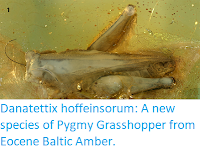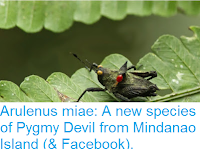Somalia and neighbouring parts of Ethiopia are suffering the worst Desert Locust, Schistocerca gregaria, outbreak in 25 years according to the Food and Agriculture Organization. The Insects have already destroyed around 700 km² of crops, and are likely to do considerable further damage, as well as potentially spreading to neighbouring countries such as Kenya, Djibouti, Eritrea, South Sudan and Sudan. The large numbers of Locusts this year are thought to have been triggered by the exceptionally heavy rains across the region, which have brought moist conditions in which the Insects thrive. The outbreak is likely to prove difficult to control as the preferred method of dealing with such events, the spraying the Locusts with insecticide from aircraft, is effectively impossible in politically unstable Somalia.
A Desert Locust, Schistocerca gregaria. Food and Agriculture Organization.
Desert Locusts typically have two or three generations
in a year, but when conditions are favourable then five or more
generations can occur. The females lay eggs in an ootheca (egg sack) in
soft sand, where they can remain dormant until conditions are favourable
or hatch within a few days. Hatchlings can reach maturity in about five
weeks, eating as much as one-and-a-half times their body weight each
day, when they are potentially able to breed again.
The adult form of the Desert Locust has two forms, the
more usual solitary form, which does not usually move far from the area
where they emerge, and a gregarious form, which forms large swarms and
can roam long distances. The change from solitary to gregarious Locusts
can happen in individuals, which change from one to the other in
response to a rise in population density, but the reverse, a change from
gregarious to solitary Locusts, can only happen when a new generation
reaches maturity.
Solitary (top) and gregarious (bottom) Desert Locust nymphs. Compton Tucker/NASA/Goddard Space Flight Center/Wikimedia Commons.
The rains this year in East Africa are thought to have been made worse by the
development of a meteorological phenomenon called a Negative Indian
Ocean Dipole. Indian Ocean Dipole Phases are similar to the El Niño/La Niña
climatic oscillation that affect the Pacific Ocean. Under normal
circumstances equatorial waters off the east coast of Africa and west
coast of Indonesia are roughly similar in temperature, however during a
Negative Indian Ocean Dipole Phase the waters off the coast of Indonesia
become significantly warmer. As the prevailing currents in the area
flow west to east, this warm water is then pushed onto the shallower
continental shelf of north Australia, where it warms the air over the
sea more rapidly, leading to increased evaporation (which fuels rain)
and a drop in air pressure over the east Indian Ocean and west Pacific.
This in turn drives air currents over the Indian Ocean to flow more
strongly west to east, leading to higher rates of cooling off the coast
of Africa (where more water is drawn up from the cool sea depths) and
more warming off the coast of Indonesia, fuelling a feedback cycle that
tends to remain through the winter season in any year when it forms.
This leads to a particularly wet winter across much of Australia, as
well as a potentially damaging heatwave in the north, while much of East
Africa is at risk of drought (during a Positive Indian Ocean Dipole
Phase the reverse happens, with drought in Australia and flooding in
East Africa).
Areas of warming and cooling and air flow during a Negative Indian Ocean Dipole Phase. Australian Bureau of Meteorology.
See also...
Follow Sciency Thoughts on Facebook.









